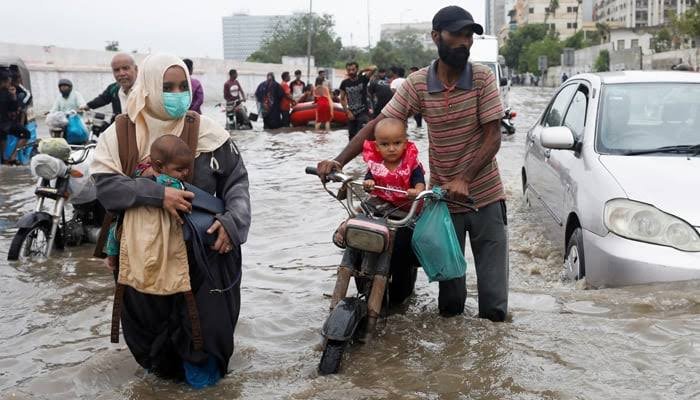City Under Water! Over 200 Evacuated as Karachi Records 129 mm Rainfall. In a dramatic weather event, Karachi experienced an unprecedented bout of torrential rain, recording 129 millimetres within a brief period. The downpour overwhelmed drainage systems, submerged key roadways, inundated residential areas, and forced the evacuation of more than 200 individuals. Emergency services, local authorities, and community volunteers mobilized swiftly, responding to a city grappling with its worst rain-related disruption in years.
The Storm’s Unfolding: Facts, Figures, and Immediate Impact
Heavy Rainfall and Flooding Across the City
Karachi’s meteorological department confirmed a staggering 129 mm of rainfall, concentrated over just a few hours. The deluge turned major thoroughfares into rivers, disrupted public transit, and cut off access to markets and schools. Homes, particularly in low-lying neighbourhoods, were inundated as water levels rose rapidly. Many families were forced to wade through knee-deep or waist-deep water to reach higher ground.
Evacuations and Emergency Response
By the time the worst of the rain subsided, authorities had evacuated more than 200 residents from flood-affected areas. Rescue teams worked through the night, using boats and jeeps adapted for flooded terrain to transport evacuees to temporary relief shelters. Medical units were dispatched to treat minor injuries and provide basic healthcare, while local relief organizations supplied blankets, dry clothing, and hot meals to those displaced.
Background: Karachi’s Flood Risk and Infrastructure Challenges
Karachi has long grappled with the vulnerabilities posed by rapid urban growth, insufficient drainage infrastructure, and encroachments on natural watercourses. Its drainage system, designed decades ago, lacks the capacity to handle flash floods. These systemic deficiencies have turned heavy rains into humanitarian emergencies with increasing frequency. In recent years, city planners and civic organizations have issued repeated warnings that without substantial upgrades and better maintenance, Karachi will remain at high risk for flood-induced crises.
Analysis: What This Event Reveals and What Lies Ahead
The Growing Threat of Climate-Driven Extremes
The 129 mm rainfall in Karachi is not an isolated incident but part of a broader pattern of extreme weather events affecting South Asia. Climate scientists point to increased atmospheric moisture, erratic monsoon patterns, and intensified storm systems as drivers behind more frequent and severe urban flooding. For Karachi, situated on the coast, the implications are especially grave. Even moderate typhoons or tropical disturbances can translate into catastrophic urban inundation when drainage and sanitation systems fail.
Infrastructure Gaps Demand Urgent Action
This crisis lays bare the urgent need for investment in Karachi’s drainage network, flood runoff channels, and water absorption systems. Urban planning must integrate blue-green infrastructure—such as retention basins, permeable surfaces, and restored wetlands—to mitigate flood risk. Equally critical is the enforcement of land-use regulations to prevent building in natural flood paths, and the regular clearing of storm drains and nullahs (city streams).
Community Awareness and Resilient Planning
While authorities responded quickly this time, long-term resilience also requires community awareness, early-warning systems, and evacuation drills. Local communities can aid rescue efforts if they are informed and prepared. Schools and neighbourhood committees can be equipped with emergency protocols. Likewise, investments in weather forecasting and public alerts via mobile networks and social media could save lives in future frightful downpours.
Conclusion and Outlook: From Crisis to Preparedness
Karachi’s recent 129 mm rainfall was both a wake-up call and a test of resilience. The evacuation of over 200 people and the immense disruption that followed underscore the fragile balance between urban growth and disaster readiness. Looking ahead, authorities must capitalize on the momentum of this event to accelerate infrastructure upgrades, build resilient systems, and foster a culture of preparedness across communities.
Without concrete reforms, similar rain-induced chaos will recur. Yet with coordinated action—combining government planning, scientific insight, community participation, and climate adaptation—Karachi can build a future where heavy rains challenge but do not cripple the city. The lessons from this deluge must translate into policy, engineering, and public awareness, securing a safer tomorrow for Pakistan’s largest metropolis.
Also Read More: India Releases 67 Pakistani Prisoners, Strengthening Diplomatic Gesture

